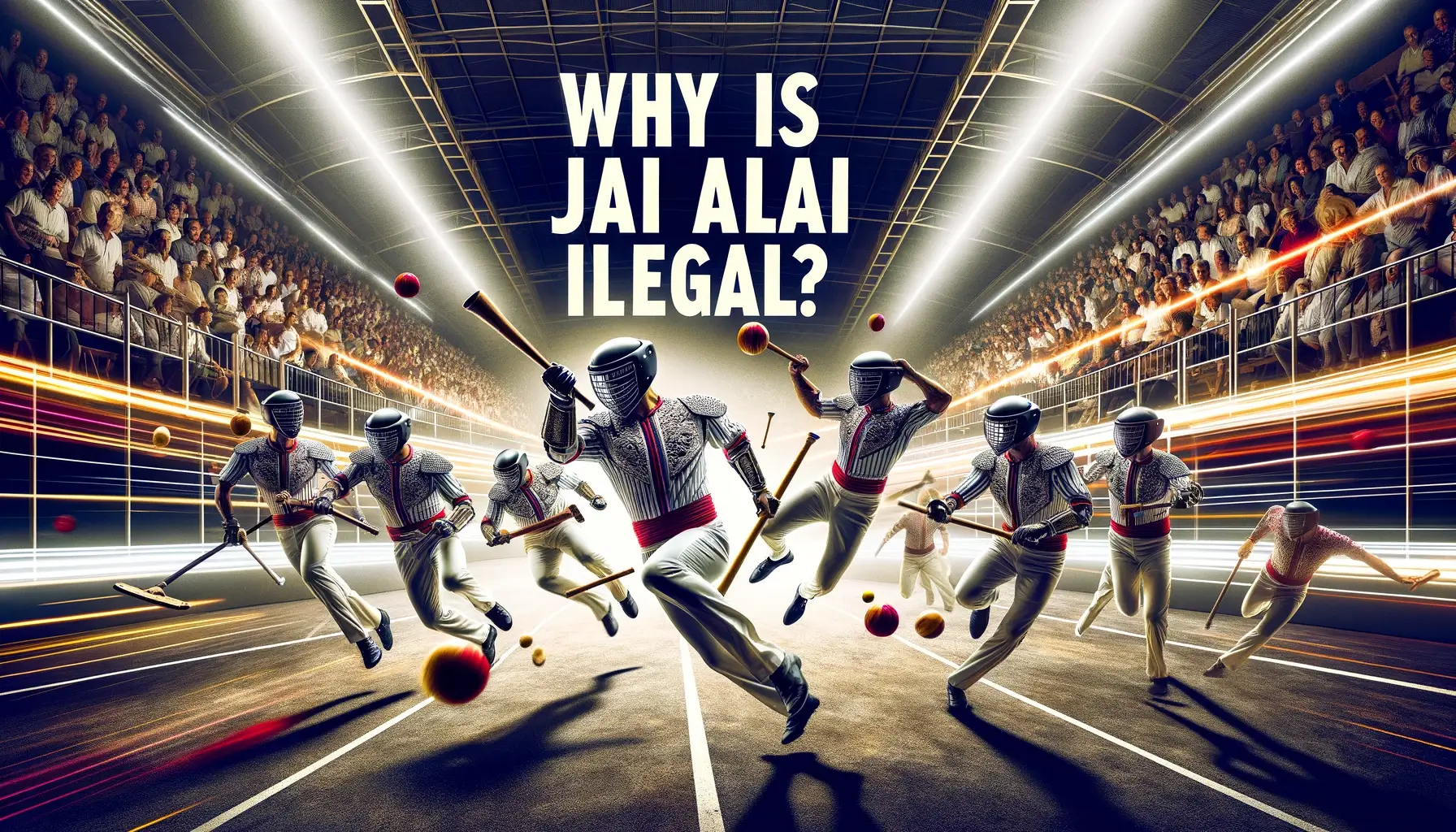Fascinating Story of Why Jai Alai is Illegal in Most Places

Have you ever heard of jai alai – that super-fast ball game with the wicker baskets? It’s a fascinating sport that was once hugely popular but is now largely illegal across most of the world. Why is jai alai illegal in so many places? That’s what we’ll explore in this article, diving into the intriguing history and reasons behind the decline of this unique sporting phenomenon.
Jai alai originated in the Basque region of Spain and France, where it developed from an early form of handball played in church courtyards. The name “jai alai” translates to “merry festival” in Basque. Despite its humble origins, it would go on to captivate audiences around the globe before falling victim to scandals and legal troubles.
The basic idea is pretty simple – players use a curved wicker cesta (basket) to hurl a rock-hard ball called a pelota at mind-boggling speeds toward a huge granite front wall. Opponents have to catch and whip it right back using insane reflexes and athleticism. It’s an adrenaline-pumping game to both play and watch.
At its peak in the mid-20th century, jai alai developed a fervent following in America. The sport’s inextricable ties to gambling culture, however, would ultimately lead to its downfall and effective illegality across most states. Let’s dive into the fascinating rise and fall of this one-of-a-kind athletic spectacle.
The Rise and Fall of a Sporting Phenomenon
Jai alai traces its roots back centuries to the villages of the Basque region, where it started as a church courtyard hobby. As the simple game spread across Spain and France, it evolved into the modern version with wicker baskets and a rock-hard ball covered in goat skin.
The true jai alai craze began when the sport hopped across the Atlantic in the late 19th century. It quickly took Latin America and the Caribbean by storm, particularly in Cuba. The first fronton (court) in the Americas opened in Havana in 1901.
American fans got their first taste of jai alai at the 1904 St. Louis World’s Fair. While that initial U.S. fronton shut down after just two months, new courts began popping up in major cities like Chicago, New Orleans, and Miami in the 1920s. Jai alai had officially arrived as a popular – and heavily gambled-upon – spectator sport.
The Golden Age arrived in the 1960s and 70s. Frontons were packaged deals, offering both the fast-paced athletic action as well as pari-mutuel betting like horse racing. At its absolute peak in 1975, over 15,000 raucous fans squeezed into Miami’s “Yankee Stadium of Jai Alai” to watch the pros in action.
The good times couldn’t last forever, though. Game-fixing scandals and mob infiltration began tainting the sport’s image by the 1970s. A perfect storm of events in the late 80s – including a crippling 3-year players’ strike – killed most of the remaining interest from American audiences.
While a few bastions remained (especially in Florida), jai alai had been knocked firmly off its mainstream pedestal. Its reasons for being outlawed in so many places traced directly back to the gambling factor that had fueled its initial popularity.
The Gambling Factor That Doomed Jai Alai
From its earliest days spreading through Spain and France, gambling was deeply intertwined with jai alai fandom. Wherever the sport took root, betting parlors were never far behind. This association would become both its blessing and its curse.
In the Americas, jai alai found its largest audience through pari-mutuel betting venues. Players were assigned numbers like horses, and fans could wager on who would win, place, or show in each game or round. For a while, this symbiotic relationship with gambling fueled the growth of the American jai alai scene.
Of course, it also opened the floodgates for illegal gambling operations, game-fixing rings, and infiltration from organized crime looking to milk the betting cash cow. Numerous frontons were burned down over the years under suspicious circumstances linked to mob activity.
Perhaps the most infamous incident occurred in 1982 when the head of World Jai Alai in Miami was found shot to death in his car trunk. He had been investigating – and threatening to expose – the grips that Boston mobster Whitey Bulger held over the sport’s gambling underbelly.
Scandals like these quickly turned fans away in droves. Why gamble your hard-earned cash if you suspected the matches were rigged? Despite its dazzling athleticism and frenetic pace, jai alai’s integrity was crumbling under the weight of the gambling world’s seedy elements.
State-by-State Bans and a Catastrophic Players’ Strike

As investigations into game-fixing circled and illegal betting operations were exposed, lawmakers began cracking down. Frontons that had been goldmines were suddenly shuttered by new anti-gambling legislation sweeping from state to state.
The Philippine islands offer a microcosm of the sport’s back-and-forth legality woes. After becoming a jai alai hotbed in the 20th century, the island nation banned it nationwide in 1986 due to game-fixing issues. It was re-legalized, then banned again, then re-legalized yet again – a dizzying cycle playing out over just a few decades.
Meanwhile in America, the beginning of the end came in 1988 with a historic players’ strike. At the time, most of the talent still came from the Basque region, Mexico, and other global jai alai hotbeds. Demanding better pay and working conditions, these players sat out for an astonishing three years.
When they finally returned in 1991, the American fan base had completely evaporated. Most major frontons shuttered for good, unable to recover from the triple-whammy of gambling scandals, organized crime’s involvement, and a years-long absence of top talent. The last remaining jai alai fronton in Connecticut closed its doors for the final time just a few years ago in 2021.
Could Jai Alai Make a Comeback?
So was that the final nail in jai alai’s coffin? Not quite – at least not in Florida. Thanks to the state’s permissive pari-mutuel gambling laws, a few jai alai venues have managed to cling to life as adjuncts to larger casino operations.
Loyalists still pack into places like Miami’s Magic City Casino and The Casino @ Dania Beach to catch the lightning-fast action. But instead of thousands of raucous fans, there are barely dozens watching these elite talents display jaw-dropping feats of speed and skill.
For jai alai to make a true mainstream comeback, it would likely need a complete rebranding severed from its gambling roots. Some advocates have proposed reformatting it as a non-betting athletic event, similar to tennis. But stripping away the integrated gambling component raises questions about its long-term commercial viability.
While regional interest remains high in its Basque homeland and certain Latin American pockets, jai alai’s glory days as a spectator sport of the masses feel permanently confined to the past in most parts of the world. Its startling fall from grace all traced back to the gambling ties that fueled its initial meteoric rise – a fatal catch-22 that still hasn’t been resolved.
Other Fascinating Jai Alai Facts
Whether or not jai alai can recapture mainstream popularity, its unique quirks and lore ensure it will remain a fascinating sporting footnote. For instance, did you know:
- At peak speeds exceeding 180 mph, the pelota is one of the fastest objects in all of sports. Players have to react in literal split-seconds.
- The sport was a part of the 1904 St. Louis Olympics and enjoyed a short-lived stint as an Olympic event in the early 1900s.
- During WWII, Ernest Hemingway hatched a now-infamous scheme to recruit jai alai players to help him lob hand grenades into German U-boats from his fishing vessel. Unsurprisingly, the military passed on Papa’s harebrained idea.
- Jai alai’s heyday in the 1960s-70s saw its players become minor celebrities who cultivated a “bad boy” image and attracted groupies between matches.
- The unique skills have been highlighted in shows like Mad Men, Miami Vice, and even the first Jake Gyllenhaal cult classic Bubble Boy in creative scene cameos.
So while its mainstream following may be tiny today, jai alai’s legacy as one of the world’s most unique athletic spectacles is undeniable. Its incredible backstory and rapid rise/fall remain a source of fascination for sports fans in the know.
Conclusion
At the end of the day, the root reason why jai alai is now illegal in most places across the globe comes back to its troubled history with gambling and integrity issues. What began as a simple, joyful church courtyard pastime transformed into a full-blown sporting craze riding the highs of pari-mutuel betting mania.
But jai alai’s gambling ties that fueled its growth also enabled widespread game-fixing scandals by criminal elements looking to cash in. As more states began outright banning the sport, a catastrophic 3-year players’ strike in the late 1980s killed what little mainstream interest remained from American audiences.
Today, only a few venues in Florida’s pari-mutuel industry keep jai alai’s wonderfully unique traditions alive. Die-hard fans continue enjoying the lightning-paced action, even if just a few dozen are left watching the world’s best talents showcase their skills in person.
While jai alai’s glory days of packed arenas now feel permanently confined to the past, its story stands as a captivating underdog tale of meteoric rises and falls. From humble origins tossing a ball against Spanish church walls to its wild mid-20th century highs as a celeb-studded gambling magnet, jai alai created a legacy as one of the most fascinating and controversial sports phenomena the world has ever known.






